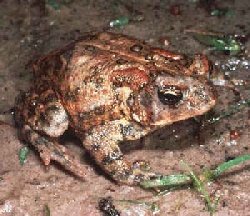|

Courtesy Dr. Robert Thomas
Amphibians have become an incredibly diverse group containing almost 4,000 species, a number rivaling that of mammals. Even though amphibians are found on every continent except Antarctica, their continued success is not guaranteed. Throughout the world, many species' numbers are declining significantly. This is the case with the Houston toad, which has been eliminated from a significant portion of its modest range in the last 30 years.
Houston toads are generally brown and speckled, but individual coloration can vary considerably, with some appearing to be light brown and others almost black. They also may have a slightly reddish, yellowish or greyish hue. Their legs have darker bands across them, and there are two dark bands extending from each eye down to the mouth. A variable white stripe usually extends down the middle of the back, but can be absent, and there are irregular white streaks along the sides of the toad’s body. Their undersides are generally white with variable amounts of black speckling. In males the throat is black. Adult Houston toads are medium-sized (2 to 3.5 inches) with females larger and bulkier than males. As with most toads, they are stout-bodied animals with short legs and rough warty skin. They move by making short hops.
Because of their inability to leap to escape from predators, toads have developed a different means of protection. First, the toads’ coloration and rough skin help to camouflage them from predators. However, if the camouflage doesn’t work, the toads have a backup. Their skin secretes potent chemicals that are distasteful, and sometimes poisonous, to predators. These chemicals are concentrated in the toads’ parotid glands, which are located just behind their heads. In addition to protecting the Houston toad from being eaten, many of these chemicals (such as serotonin and alkaloids) are used as medicines to treat heart and nervous disorders in humans.

Courtesy Dr. Robert Thomas
More Information on the Houston Toad:
Habitat and Distribution
Life History
Threats to Houston Toad Survival
Houston Toad Links
Houston Toad Data Sheet
|

